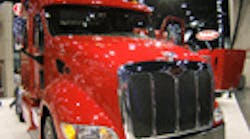DALLAS, TX – If anyone is supposed to have a crystal ball in the truck manufacturing business, it’s Tony McQuary, senior director of strategic business planning for Peterbilt Motors Co. It’s his job to look down the road one, three, five, even 10 years and figure out what customers are going to need from their trucks – even if customers themselves don’t know what they’ll need.
“When we do field research with customer fleets, not only is it important to listen to what they tell you they need, but also especially what they don’t tell you,” McQuary explained to FleetOwner at a dinner ahead of the Great American Truck Show.
“We have a team where all they do is go on customer visits and they are looking closely at everything, no matter how small,” he said. “Maybe a switch on the dash needs to get relocated because the driver is stretching frequently to reach it. The driver may not verbalize that this is an issue, but it is and we need to note that.”
McQuary is also tasked with looking at the “big picture,” not only for trucks themselves but how they are built, especially in terms of reducing the environmental impact of the manufacturing process. “That’s a major focus for us now,” he said.
McQuary, who served in a similar capacity at Kenworth Trucks for 16 years before moving over sister company Peterbilt a year and a half ago, also taps into what’s going on in Europe’s truck world – the home market for DAF, another sister firm, as all three are owned by Paccar.
“Europe’s had a lot of experience with SCR [selective catalytic reduction] technology to meet their emission standards and we’ll be using it to meet 2010 rules here in the U.S.,” he said. “The issue for us is adapting SCR to fit how trucks operate in the U.S. For example, the tanks holding the urea solution sprayed into the truck’s exhaust stream to control NOx [oxides of nitrogen] emissions is small in Europe – between five and 20 gallons. We’ll need a 25 to 40 gallon tank for trucks in North America because they operate over much longer distances.”
The SCR tank not only adds weight, it takes up already limited real estate on today’s Class 8 truck – an issue McQuary thinks will be addressed by sizing down the main diesel fuel tanks on Class 8 tractors. “You’re looking at going from a 250-gallon tank down to 200 gallons,” he said.
There’s also the issue of maintaining urea in a liquid state, as it freezes around 12 degrees Fahrenheit. “In Europe, they let it freeze and allow the truck to operate until the liquid thaws,” he noted. “In the U.S. we think that won’t be allowed – that if the urea freezes, the truck won’t be allowed to operate. So we are looking at ways to keep the urea in a liquid state as efficiently as possible.”
View more Fleet Owner management news and other commercial trucking-related articles.




